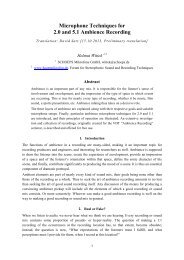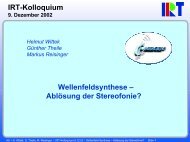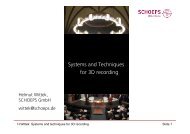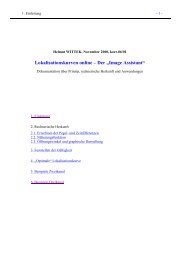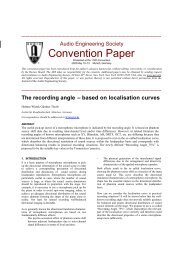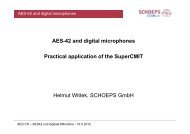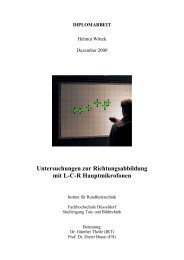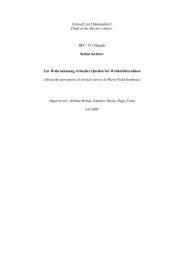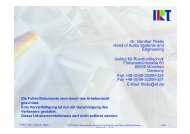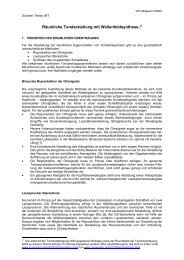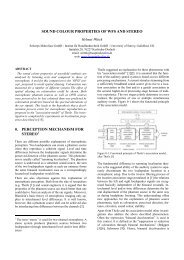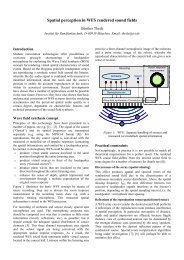on the localisation in the superimposed soundfield - Hauptmikrofon ...
on the localisation in the superimposed soundfield - Hauptmikrofon ...
on the localisation in the superimposed soundfield - Hauptmikrofon ...
You also want an ePaper? Increase the reach of your titles
YUMPU automatically turns print PDFs into web optimized ePapers that Google loves.
4<br />
1. Introducti<strong>on</strong><br />
In <strong>the</strong> c<strong>on</strong>text of spatial hear<strong>in</strong>g, BLAUERT 1974 def<strong>in</strong>ed <strong>the</strong> term “localisati<strong>on</strong>” as<br />
<strong>the</strong> mapp<strong>in</strong>g of <strong>the</strong> locati<strong>on</strong> of an auditory event to certa<strong>in</strong> characteristics of a sound<br />
event. If, based <strong>on</strong> BLAUERT 1969, <strong>the</strong> term “auditory event” is generally<br />
understood to describe <strong>the</strong> “auditory percepti<strong>on</strong> determ<strong>in</strong>ed by temporal, spatial and<br />
o<strong>the</strong>r attributes” and <strong>the</strong> term “sound event” as <strong>the</strong> equally determ<strong>in</strong>ed “physical<br />
aspect of <strong>the</strong> listen<strong>in</strong>g process”, <strong>the</strong>n <strong>in</strong>itially <strong>on</strong>e obta<strong>in</strong>s an important descriptive<br />
basis for <strong>in</strong>vestigati<strong>on</strong>s <strong>in</strong>to spatial hear<strong>in</strong>g.<br />
Dur<strong>in</strong>g <strong>the</strong> course of this work, however, it has been found that as so<strong>on</strong> as more than<br />
<strong>on</strong>e sound source determ<strong>in</strong>es <strong>the</strong> properties of <strong>the</strong> ear signals, a more precise<br />
def<strong>in</strong>iti<strong>on</strong> of terms is required.<br />
Under natural c<strong>on</strong>diti<strong>on</strong>s, <strong>the</strong> listen<strong>in</strong>g process predom<strong>in</strong>antly takes place <strong>in</strong> a<br />
<strong>superimposed</strong> sound field. Normally, a multitude of <strong>in</strong>terfer<strong>in</strong>g sources [e.g.<br />
reflecti<strong>on</strong>s from <strong>the</strong> floor or room boundaries (mirror sources)] but also equipollent<br />
sound sources (e.g. different speakers <strong>in</strong> <strong>the</strong> vic<strong>in</strong>ity of a listener) produce ear signals<br />
that do not corresp<strong>on</strong>d <strong>in</strong> any way to <strong>the</strong> elementary case of a s<strong>in</strong>gle sound source.<br />
Yet, even under such sound field c<strong>on</strong>diti<strong>on</strong>s, <strong>the</strong> human hear<strong>in</strong>g system is capable of<br />
“carry<strong>in</strong>g out a very mean<strong>in</strong>gful selecti<strong>on</strong>, order<strong>in</strong>g and group<strong>in</strong>g process” (PLENGE<br />
1973), so that, despite <strong>the</strong> superpositi<strong>on</strong>, <strong>the</strong> auditory event mapp<strong>in</strong>gs can be<br />
accomplished. In this respect, two well-known auditory phenomena are <strong>the</strong> “law of<br />
<strong>the</strong> first wavefr<strong>on</strong>t” (CREMER 1948) and <strong>the</strong> “cocktail party effect” (CHERRY 1953,<br />
1954).<br />
It appears that <strong>in</strong> <strong>the</strong> <strong>superimposed</strong> sound field <strong>the</strong> localisati<strong>on</strong> mechanism relies <strong>on</strong><br />
underly<strong>in</strong>g processes that are not directly applicable to <strong>the</strong> localisati<strong>on</strong> of a s<strong>in</strong>gle<br />
sound source <strong>in</strong> a free sound field. These are all those processes that enable a separate<br />
evaluati<strong>on</strong> of certa<strong>in</strong> ear signal comp<strong>on</strong>ents.<br />
What are <strong>the</strong> ear signal comp<strong>on</strong>ents that <strong>the</strong> auditory system discrim<strong>in</strong>ates <strong>in</strong> <strong>the</strong><br />
<strong>superimposed</strong> sound field? Which characteristics of a sound event allow for this to<br />
happen?<br />
The literature is full of <strong>in</strong>vestigati<strong>on</strong>s address<strong>in</strong>g <strong>the</strong>se two questi<strong>on</strong>s. Most notably,<br />
this is <strong>the</strong> case for all studies <strong>in</strong>to <strong>the</strong> phenomena of <strong>the</strong> “phantom source”, <strong>the</strong> “law of<br />
<strong>the</strong> first wavefr<strong>on</strong>t” and <strong>the</strong> “cocktail party effect” (see BLAUERT 1974 for<br />
references as well as <strong>the</strong> follow<strong>in</strong>g secti<strong>on</strong>s of this <strong>the</strong>sis). Fur<strong>the</strong>rmore, <strong>in</strong>vestigati<strong>on</strong>s<br />
<strong>in</strong> <strong>the</strong> area of b<strong>in</strong>aural signal detecti<strong>on</strong> (see BLAUERT 1974 for references as well as<br />
DOMNITZ / COLBURN 1976, 1977, HAFTER 1977, KOENIG et al. 1977, ALLEN<br />
et al. 1977, HAWKINS et al. 1978, HAFTER et al. 1979) and some studies<br />
c<strong>on</strong>cern<strong>in</strong>g particular questi<strong>on</strong>s of auditory percepti<strong>on</strong> (e.g. see PLENGE 1973 for



